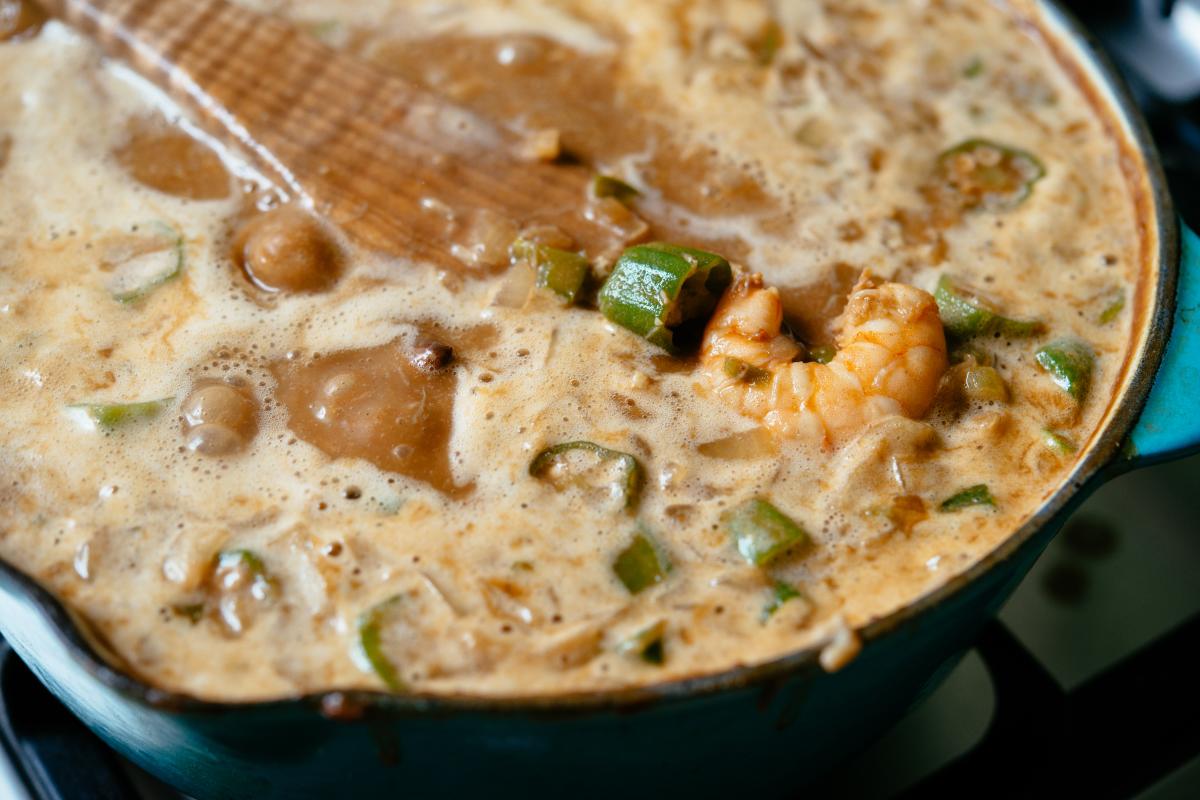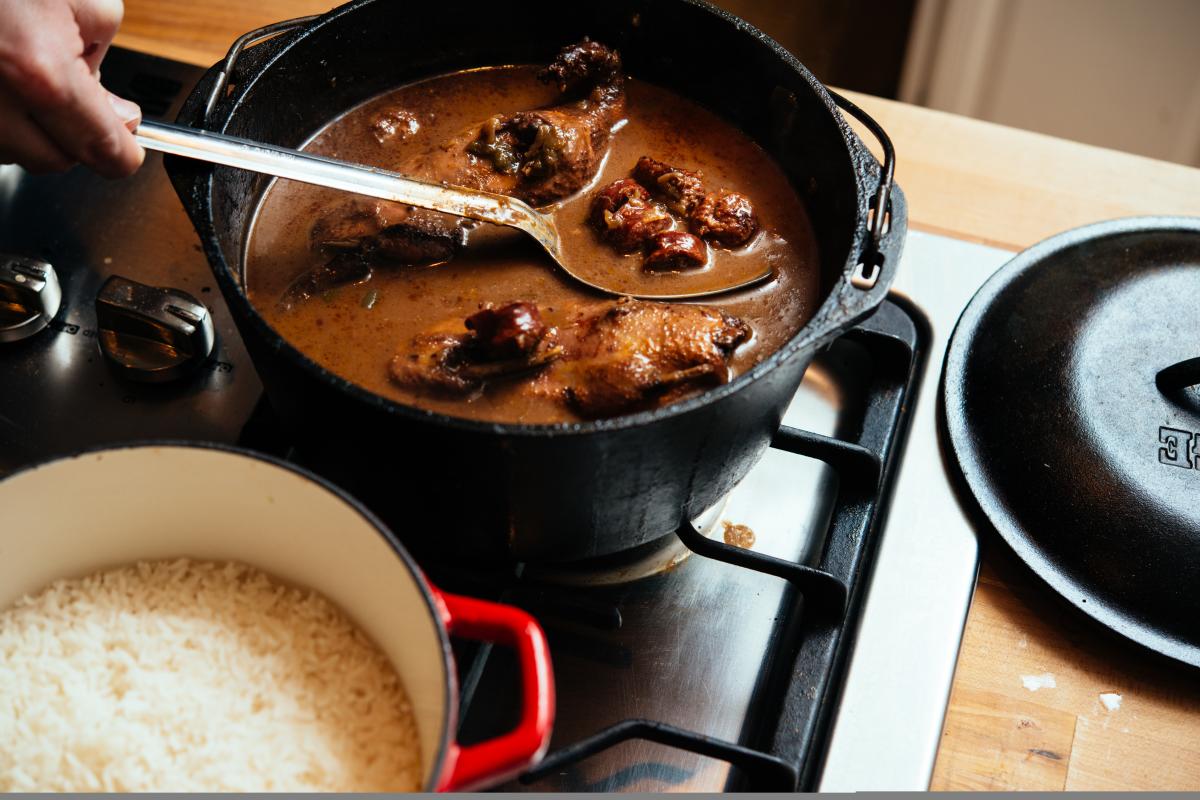It’s no oversimplification to say that until my twenties, there was no concept of gumbo in my life other than what my mom made. This is not a pointed literary exaggeration, it’s a fact of life shared by pretty much every gumbo eater across Louisiana. Gumbo is what your momma made, a definition that assures that there are as many different types of gumbos as there are mothers who make them. Sometimes it’s caramel colored roux, okra, tomatoes, shrimp and crab seasoned delicately and thickened slightly to the viscosity of a soup. Sometimes it’s a chocolate brown roux, thick as a stew and brimming with lumps of chicken and sausage. Still others have no roux at all and are served entirely with greens and legumes. Gumbos are typically served over steamed white rice, but some tables prefer sweet potatoes or potato salad. The variation is maddening when trying to sort out what makes gumbo, gumbo. Tethered to maternally inherited convictions, my own gumbo quest nearly drowned me in delicious but unsettling waters.

When I was in college, I came across a can of Campbell’s Chicken and Gumbo Soup at a Kroger grocery store near my house in Atlanta, and chuckled arrogantly at the ingredient list: tomatoes (diced), tomato puree, chicken meat, rice, andouille sausage, celery, okra, bell peppers. Tomatoes? Okra? Not even a cursory milligram of roux? I was young and naive. As far as I was concerned that was no gumbo. No sir. My culinary tower was but a house of saltine crackers, soon dipped in the murky stews of gumbo history, sogged to its base, and collapsed.
Details about the origins of gumbo are murky. A dish called gumbo doesn’t really show up in historical record until the beginning of the 19th century, when the word starts showing up prolifically in correspondence. What it was isn’t exactly clear except that it most likely included okra, given that the name derives directly from the West African word for the gooey vegetable, kimbombo, and was served primarily with seafood. African slaves arrived in the port of New Orleans toting okra seeds and a rich culinary tradition that became profoundly influential on Creole foodways. Mingling with the rich variety of European and Native American food traditions that converged in New Orleans, gumbo emerged from the void a broth thickened with okra and served over starch, at that time a corn meal mush. This was the primordial gumbo.

Over the next 100 years, that soup-like substance evolved into what we moderns call gumbo. By 1885, La Cuisine Creole, one of the earliest published Creole cookbooks, documented several different recipes for gumbo (called gombo in the book), served over rice with a variety of proteins. Recipes for chicken and okra, oyster and okra, shrimp and okra, or just okra gumbos are included noting that they are “a most excellent form of soup” particularly well suited to re-using leftover meats and vegetables. Rice became the ubiquitous base when German and Acadian farmers across the state began cultivating the grain in commercial quantities in the late 19th century, making it a cheap and available starch statewide.
Innocuous though it may seem, that Creole cooks considered gumbo a soup is integral to seeing a division in the conception and creation of the dish as it is found across Louisiana. Growing up in Lafayette, what my mom made was a salty, luscious mélange of tender chicken and smoked andouille sausage swimming in a fresh chicken stock thickened by a roux the color of café au lait. A slow simmer coaxed spicy and aromatic flavors from tasso, a heavily salted and spicy cut of pork, and the Cajun mirepoix of onions, green peppers, and celery, held sacred as the Cajun “trinity”. It was always served over rice, sometimes with potato salad, and sometimes thickened by a little file’ (dried sassafrass leaves) if the gumbo was immature. But it was not something I would dare call a soup. Gumbo, to me, was sui generis.

Ask folks from closer to New Orleans what gumbos their mothers made and you might wonder if you’re talking about the same food. East of the Mississippi gumbo is typically a less hardy dish. Like my mom’s, it’s served over rice but maybe not as much. The roux is lighter, the broth is thickened with okra, brightened with tomatoes and finished with lumps of crab or shrimp or oysters or whatever seafood is fresh and available. No old guard New Orleanian, as far as I know, serves it with potato salad.
Mary Tutwiler, a New Orleans- born/Lafayette-transplanted food writer and chef, grew up with a notion of gumbo more similar to that Campbell’s tin can. For Mary and generations of New Orleanians before her, gumbo was okra and tomatoes and pretty much all of the seafood you could get your hands on. The content of the pot was thrown together by the cosmopolitan port scene of late 18th and 19th century New Orleans. Gumbo evolved into a multifaceted dish complete with contributions from the city’s many heralded nations. From the Spanish early gumbos stocked ham, from the aforementioned West African slaves came okra and a name, from the Choctaw tribes file’, and from the bounty of the Gulf of Mexico an abundance of seafood.

When Mary arrived in Lafayette in the 1970s, she first encountered poultry and sausage gumbos. “I had never seen or tasted chicken and sausage gumbo, and that was the only gumbo out here,” she told me. There she ate darker, richer-textured varieties like the smoked duck and andouille gumbo Chef Pat Mould created at the seminal Lafayette eatery Charly G’s in the 1980s, bringing hunting camp gumbo fare to the burgeoning restaurant scene. Its inheritance was the southwest Louisiana campfire gumbos, to which hunters brought game to the pot, adorning their stocks with browned meat and sharing beers after a winter hunt.
That gumbo could be anything other than the chicken and sausage perfection cooked by Chef Pat or my mom was a revelation. That those weren’t the original, platonic forms of gumbo was, for me, an existential crisis. But for Mary, despite the substantial differences in appearance, she knew a gumbo when she saw it. “To me gumbo is a roux-based soup,” she said, “after that, anything that winds up in the pot is fair game.”

While gumbos speak different languages, they have a common root: roux, a thickener made of flour browned in oil. Roux in general is credited to Louisiana’s French heritage, though others have suggested that the browning of starches comes from Native American cooking techniques. Louisiana tribes like Choctaws and Houmas were known to brown corn meal to add flavor and preserve them. French-influenced communities such as colonial African slaves and Acadian exiles would have been familiar with the technique via browned butters and bechamel in French cooking, and adopted it to their needs.
Like everything else in a gumbo, how dark your roux gets depends on where you live. Closer to New Orleans, roux tends toward lighter shades, looking at its darkest like light caramel. The further west you go, a dark roux can trick the uninitiated into believing it’s a pan of simmering chocolate ganache, a mistake often made by sweet-toothed kids around Christmas. The exact reason for the variance is unclear, though best guesses are that roux colors change to accommodate different proteins: lighter roux for delicate meats like seafood and darker roux for gamier fare like poultry or sausage. Once the roux is in the stock, however, gumbos of different shades and flavors blossom across the bayous.

Taking in the variety, it becomes readily clear that gumbo is not so much a singular dish. According to folklorist John Laudun, “gumbo is not a word, it’s a syntax, a way of putting something together.” It reveals a concentric rather than linear evolution of the food, bubbling from identical cultural stews scattered throughout southern Louisiana. Germans, French, Spaniards, Italians, Africans, and Native Americans fell into cultural exchange throughout the state. Thus, the same kinds of influences abound across the various parish lines, and are responsible for simultaneous innovation in a Louisiana national dish that is more exceptions than rules. Citizens of Vermillion Parish and St. Mary Parish in south Acadiana are just as likely to include seafood in their gumbos as the Creoles of New Orleans. Some parts of northern Acadiana include sweet potatoes, while garlic makes its way into pots along the Bayou Teche where Italian heritage is prominent. Eggs are sometimes thrown to the mix to add protein to shrimp gumbos on a stretched budget, soaking up the briny shrimp flavors. It’s a heterogeneous landscape.
Where I went wrong on my quest was trying to track down a universal definition for gumbo. Gumbo is not one thing. But its definition is nevertheless apparent. For something to truly be gumbo it must participate in the unique Louisiana culinary heritage of Cajuns, Creoles, Spaniards, Germans, Italians, Irish, Choctaws, Coushattas, Houmas, and all kinds of other peoples, places and things. It more often than not will have a roux, which will come in varying volumes, shades, and tastes. It will be served with a spoonful or cupful of rice, or thickened with okra or file’, or enriched by poultry marrow and andouille smoke. It may come from New Orleans, but it’s at home in Lafayette. And no matter how your mother made hers, you will know a gumbo when you see it.
